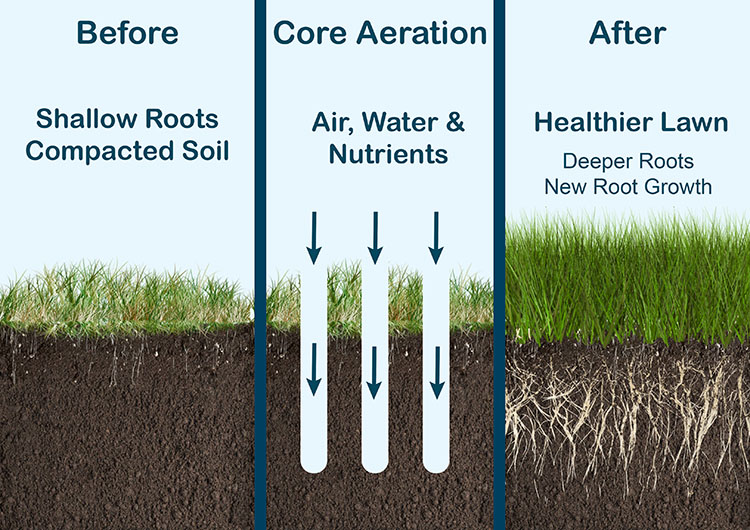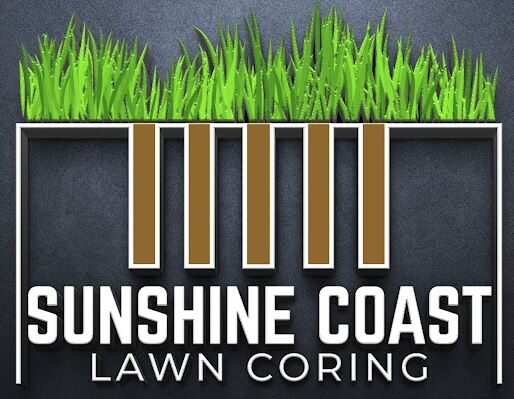Lawn Coring
Sunshine Coast Lawn Coring can transform your lawn from dry to a lush lawn that the neighbours would love to have.
Lawn coring sunshine coast
What is Lawn coring / Aeration?
Lawn coring, also known as aeration or core cultivation, is a process of removing small plugs of soil from a lawn. This is done by using a special machine called an aerator that makes small holes in the ground and pulls out the cores of soil and thatch.
The main purpose of lawn coring is to improve soil aeration, drainage, and overall lawn health. By creating small holes in the soil, the process allows air, water, and nutrients to penetrate deeper into the soil, reaching the roots of the grass. This can promote healthier root growth and reduce soil compaction, which can lead to better nutrient uptake and a thicker, more robust lawn.
In addition to improving soil health, lawn coring can also help to reduce thatch buildup, which is a layer of dead grass and other organic matter that accumulates on the surface of the soil over time. Removing this layer can allow for better water and nutrient absorption, leading to a healthier lawn overall.
The frequency of lawn coring depends on several factors, including soil type, the current level of compaction present and the level of foot traffic. In general, it is recommended to core aerate every 6 months with highly compacted lawns or once a year showing an aerated soil profile.
This Service is done year-round, with most customers opting in for 6 monthly as we are always working on improving your soil profile.
Does my lawn really need lawn aeration?
Heavily compacted soil vs healthy aerated soil provide considerable differences when growing anything, a perfect example is buying a new plant from a nursery! when you bring it home, you plant it in some lovely fluffy potty mix and the plant flourishes as the roots water and nutrients are readily accessible.
If we went to plant that same plant in the soil of our lawn after having years of compaction from rain, mowing, dogs, people, and cars compacting the soil for many years, we will find it will have huge difficulty growing. Soil compaction locks up nutrients and prevents water from penetrating the soil profile efficiently and producing weeds that thrive in these conditions.
So if you’re looking for a simple, effective way to improve the health and appearance of your lawn, then lawn coring is definitely worth considering. With its many benefits and proven track record, it’s a surefire way to give your lawn the boost it needs to look its best all year round!
For more information or to organise a quote for your project please get in touch with us.

Lawn Aeration FAQ's
Lawn Coring should be done when compacted soil is known and present,
Hard, difficult-to-penetrate soil: Compacted soil is often hard and difficult to penetrate with a shovel or garden fork.
Poor water drainage: Compacted soil may have poor water drainage and may remain wet for long periods of time after rain or watering.
Limited plant growth: Plants growing in compacted soil may have stunted growth or may not grow at all. Their roots may also appear stunted or restricted in growth.
Increased erosion: Soil erosion can increase on compacted soils as the compacted surface can not retain water or nutrients effectively.
Puddling or pooling: After rainfall, compacted soil may form puddles or pools of water that remain for long periods of time, leading to waterlogging.
Soil appears hard or dense: If the soil appears hard or dense, it is a sign that it may be compacted.
If you suspect that your soil is compacted, you can use a soil penetrometer or an auger to measure the soil density and depth of the compacted layer. Another way to check is by observing the root penetration of plants, which should be straight and deep in loose soil.
Yes, but it may need more the just coring.
I healthy lawn relies on consistency of mowing, water nutrition.
We can put you in the right direction to achieve your lawns goals.
We have the ability to do the smallest courtyards with machines that are capable to access small gates.
We also have various larger machines which provide our customers with large areas like acreage and sports fields.
No, however pets should be kept away during the process
Please ensure we have access available to the areas we are treating and clear of any obstacles , if you have sprinklers please have them flagged to ensure we know where they are while conducting the lawn coring process.
The Lawn coring will improve the ability for water absorption and nutrients uptake and roots air to breathe, with regular watering and fertilising you should see a improvement in a as short as a week!
Our machines are far from stock machines, providing larger diameter holes up to 22mm and tine weight exceeding from 65kg-95 kg per tine of down force. With the ability of pulling cores from 70-140mm long.
Typical hire machines are hired to you with the companies’ best interest in mind, Maintaince.
Hire machines have a lot lower tine weight under 45kg and smaller tine as narrow as 16-12mm resulting in inferior results and for compacted soils to the point of almost concrete, not doing any benefit at all.
Lawn coring is depth is dependent on the type of machine, how it works, its penetration weight per tine, as well as the resistance of compaction coming from your soil profile. If your lawn is really compacted, You can expect cores to be relatively short 10-20mm, if low compaction our machines can provide lawn cores from 70-140mm in length.
Depending on the level of lawn you have you have 3 options when taking care of the cores after lawn core aeration. First let them dry out if you’re going to use the lawn mower options!
- Rake them up and remove, you can also spread these of bare areas of lawn with regular watering will somewhat transplant the grass as the cores are full of leaf and root compound.
- Catch them with your rotary mower, this will pick up the cores and you can also remove them or spread them over bare patches of your lawn.
- Mulch them in with your rotary mower, the cores we pull up are full of good existing soil and nutrients, let them dry out and mow them back in for free topsoil.
As light as animals are, the amount of weight on their little paws running the same line in your yard will heavily increase compaction in that area, crushing the root zone, compacting the soil in that area, preventing grass to grow, this is a perfect example on how compaction occurs.
How often should I aerate my lawn? Compacted soils should be aerated regularly until the area is deemed well aerated, a highly aerated lawn is very easy to look after, as the roots are able to go deep,
Depending on the amount of grass present and weeds we need to control it can take a season or 2 of good maintenance, its best to get on top of all the problems with the lawn as we only have about 6 months a year to get as much as we can to recover prior to heading into winter where to lawn goes somewhat dormant.
